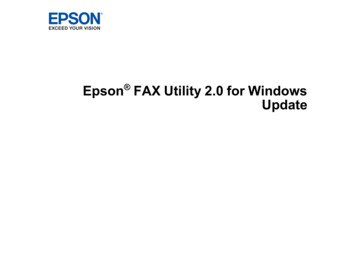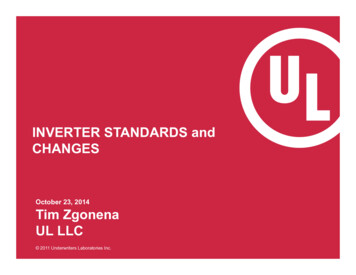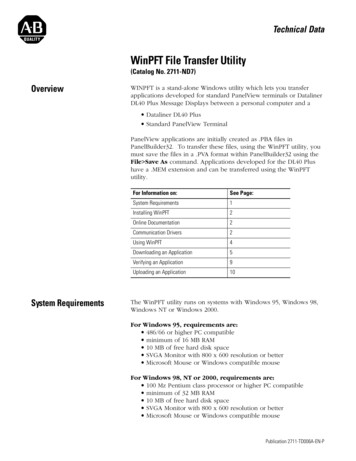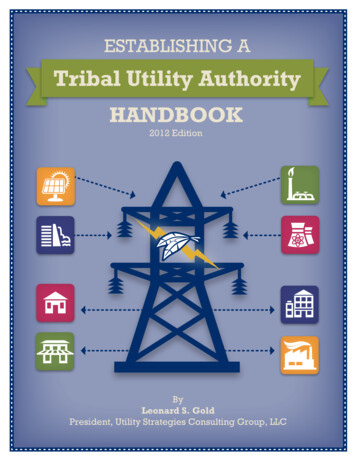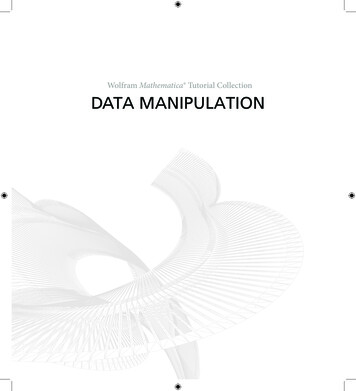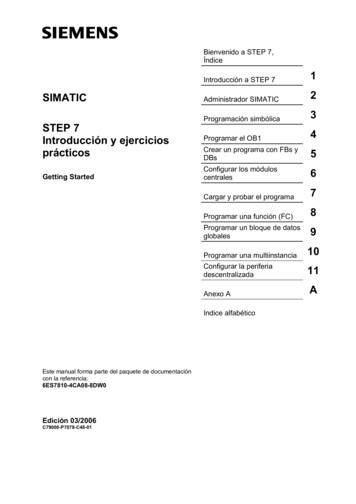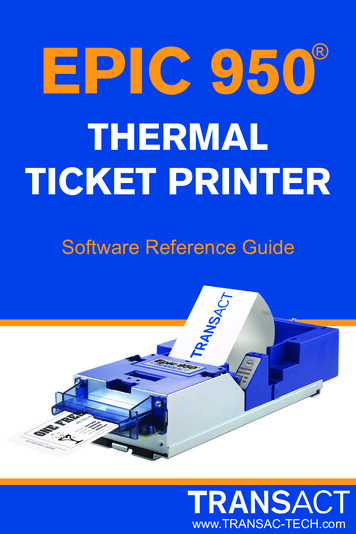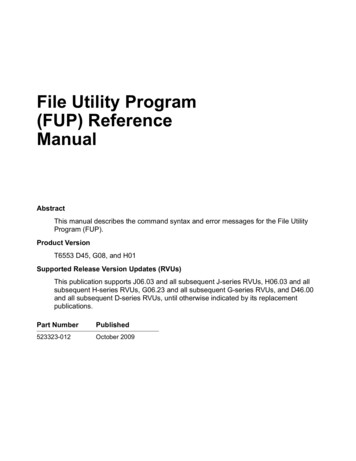
Transcription
File Utility Program(FUP) ReferenceManualAbstractThis manual describes the command syntax and error messages for the File UtilityProgram (FUP).Product VersionT6553 D45, G08, and H01Supported Release Version Updates (RVUs)This publication supports J06.03 and all subsequent J-series RVUs, H06.03 and allsubsequent H-series RVUs, G06.23 and all subsequent G-series RVUs, and D46.00and all subsequent D-series RVUs, until otherwise indicated by its replacementpublications.Part NumberPublished523323-012October 2009
Document HistoryPart NumberProduct VersionPublished523323-004FUP D45 and G08April 2004523323-007FUP D45, G08, and H01July 2005523323-009FUP D45, G08, and H01July 2006523323-010FUP D45, G08, and H01November 2006523323-012FUP D45, G08, and H01October 2009
Legal Notices Copyright 2009 Hewlett-Packard Development Company L.P.Confidential computer software. Valid license from HP required for possession, use or copying.Consistent with FAR 12.211 and 12.212, Commercial Computer Software, Computer SoftwareDocumentation, and Technical Data for Commercial Items are licensed to the U.S. Government undervendor's standard commercial license.The information contained herein is subject to change without notice. The only warranties for HPproducts and services are set forth in the express warranty statements accompanying such productsand services. Nothing herein should be construed as constituting an additional warranty. HP shall not beliable for technical or editorial errors or omissions contained herein.Export of the information contained in this publication may require authorization from the U.S.Department of Commerce.Microsoft, Windows, and Windows NT are U.S. registered trademarks of Microsoft Corporation.Intel, Itanium, Pentium, and Celeron are trademarks or registered trademarks of Intel Corporation or itssubsidiaries in the United States and other countries.Java is a U.S. trademark of Sun Microsystems, Inc.Motif, OSF/1, UNIX, X/Open, and the "X" device are registered trademarks and IT DialTone and TheOpen Group are trademarks of The Open Group in the U.S. and other countries.Open Software Foundation, OSF, the OSF logo, OSF/1, OSF/Motif, and Motif are trademarks of theOpen Software Foundation, Inc.OSF MAKES NO WARRANTY OF ANY KIND WITH REGARD TO THE OSF MATERIAL PROVIDEDHEREIN, INCLUDING, BUT NOT LIMITED TO, THE IMPLIED WARRANTIES OFMERCHANTABILITY AND FITNESS FOR A PARTICULAR PURPOSE.OSF shall not be liable for errors contained herein or for incidental consequential damages inconnection with the furnishing, performance, or use of this material. 1990, 1991, 1992, 1993 Open Software Foundation, Inc. This documentation and the software towhich it relates are derived in part from materials supplied by the following: 1987, 1988, 1989 Carnegie-Mellon University. 1989, 1990, 1991 Digital Equipment Corporation. 1985, 1988, 1989, 1990 Encore Computer Corporation. 1988 Free Software Foundation, Inc. 1987, 1988, 1989, 1990, 1991 Hewlett-Packard Company. 1985, 1987, 1988, 1989, 1990, 1991,1992 International Business Machines Corporation. 1988, 1989 Massachusetts Institute ofTechnology. 1988, 1989, 1990 Mentat Inc. 1988 Microsoft Corporation. 1987, 1988, 1989,1990, 1991, 1992 SecureWare, Inc. 1990, 1991 Siemens Nixdorf Informationssysteme AG. 1986,1989, 1996, 1997 Sun Microsystems, Inc. 1989, 1990, 1991 Transarc Corporation.This software and documentation are based in part on the Fourth Berkeley Software Distributionunder license from The Regents of the University of California. OSF acknowledges the followingindividuals and institutions for their role in its development: Kenneth C.R.C. Arnold,Gregory S. Couch, Conrad C. Huang, Ed James, Symmetric Computer Systems, Robert Elz. 1980,1981, 1982, 1983, 1985, 1986, 1987, 1988, 1989 Regents of the University of California.Printed in the US
File Utility Program (FUP)Reference ManualGlossaryIndexExamplesTablesLegal NoticesWhat’s New in This Manual ixManual Information ixNew and Changed InformationAbout This Manual xiiiOrganization of This ManualAdditional Information xivNotation Conventions xivixxiii1. FUP OverviewStarting a FUP Process 1-2At the TACL Prompt 1-2Interactively 1-3From a Command File 1-3Command Files 1-3Run Options 1-4Using FUP Custom Files 1-4FUP Custom File Guidelines 1-4FUP Custom File Example 1-5Interrupting or Terminating a FUP ProcessEntering a FUP Command 1-5FUP Command Guideline 1-7FUP Command Examples 1-7Specifying Files 1-8Listfile Parameter 1-8Fileset-list Parameter 1-9Fileset Parameter 1-9Wild-Card Option 1-10Qualified File Sets 1-11Creating Files 1-19Examples of Creating Files 1-191-5Hewlett-Packard Company—523323-012i
Contents1. FUP Overview (continued)1. FUP Overview (continued)Partitioning Files 1-20Examples of Partitioning Files 1-20Using DEFINEs With FUP 1-21SPOOL DEFINEs 1-21MAP DEFINEs 1-22TAPE DEFINEs 1-22Handling Different Types of Files 1-22Handling File Formats 1-22Moving Format 1 File Contents to Format 2Handling OSS Files 1-24Handling SQL/MP Files 1-24Handling SQL/MX Files 1-27Handling SMF Files 1-281-232. FUP Commands!2-4! Guidelines 2-4! Examples 2-4Commands Related to ! 2-5? 2-5? Guidelines 2-5Commands Related to ? 2-6ALLOCATE 2-6ALLOCATE Guidelines 2-6ALLOCATE Examples 2-7Commands Related to ALLOCATE 2-8ALLOW 2-9ALTER 2-9ALTER Parameters for All File Types 2-10ALTER Parameters for Files With Alternate-Key FieldsALTER Parameters for Partitioned Files 2-15ALTER Parameter for Unstructured Files 2-18ALTER Guidelines 2-18ALTER Examples 2-20Commands Related to ALTER 2-20BUILDKEYRECORDS 2-21BUILDKEYRECORDS Guidelines 2-22BUILDKEYRECORDS Example 2-232-13File Utility Program (FUP) Reference Manual—523323-012ii
Contents2. FUP Commands (continued)2. FUP Commands (continued)Commands Related to BUILDKEYRECORDS2-23CHECKSUM 2-24CHECKSUM Guidelines 2-24CHECKSUM Examples 2-25CONFIG[URE] 2-26CONFIG[URE] Guidelines 2-31CONFIG[URE] Examples 2-33Commands Related to CONFIG[URE] 2-35COPY: Copy Form 2-36COPY: Copy Form Guidelines 2-51COPY: Copy Form Examples 2-53Commands Related to Copy: Copy Form 2-54COPY: Display Form 2-55Copy: Display Form Listing Format 2-56Copy: Display Form Examples 2-57CREATE 2-58CREATE Guidelines 2-58CREATE Examples 2-59Commands Related to CREATE 2-61DEALLOCATE 2-61DEALLOCATE Guidelines 2-61DEALLOCATE Example 2-62Commands Related to DEALLOCATE 2-62DISPLAYBITS 2-62DUP[LICATE] 2-62DUP[LICATE] General Guidelines 2-67DUP[LICATE] Guidelines for Safeguard Files 2-69DUP[LICATE] Examples 2-69Commands Related to DUP[LICATE] 2-71EXIT 2-71EXIT Guidelines 2-71EXIT Example 2-71FC 2-71FC Guidelines 2-72FC Examples 2-73Commands Related to FC 2-73FILENAMES 2-73FILENAMES Example 2-74File Utility Program (FUP) Reference Manual—523323-012iii
Contents2. FUP Commands (continued)2. FUP Commands (continued)Commands Related to FILENAMES 2-74FILES 2-75FILES Guidelines 2-76FILES Examples 2-76Commands Related to FILES 2-76GIVE 2-77GIVE Guidelines 2-77GIVE Examples 2-78HELP 2-79HELP Examples 2-79HISTORY 2-80HISTORY Guidelines 2-80HISTORY Example 2-81Commands Related to HISTORY 2-81INFO 2-81INFO Guidelines 2-84INFO Listing Format 2-85INFO Listing Format Example 2-97INFO DETAIL Listing Format 2-98INFO DETAIL Listing Format Examples 2-105INFO STATISTICS Listing Format 2-112INFO STATISTICS Listing Format Examples 2-113INFO EXTENTS Listing Format 2-115INFO EXTENTS Listing Format Examples 2-115Commands Related to INFO 2-116LICENSE (Super ID) 2-116LICENSE (Super ID) Guidelines 2-117LICENSE (Super ID) Examples 2-117Commands Related to LICENSE (Super ID) 2-117LISTLOCKS 2-117LISTLOCKS Listing Format 2-119LISTLOCKS Guidelines 2-121LISTLOCKS Example 2-122LISTOPENS 2-123LISTOPENS Listing Format 2-124LISTOPENS Guidelines 2-126LISTOPENS Examples 2-128LOAD 2-130File Utility Program (FUP) Reference Manual—523323-012iv
Contents2. FUP Commands (continued)2. FUP Commands (continued)LOAD Guidelines 2-134LOAD Examples 2-136Commands Related to LOAD 2-137LOADALTFILE 2-137LOADALTFILE Guidelines 2-138LOADALTFILE Example 2-139Commands Related to LOADALTFILE 2-139OBEY 2-139OBEY Guidelines 2-139OBEY Example 2-140PURGE 2-140PURGE Guidelines 2-142PURGE Examples 2-143Commands Related to PURGE 2-145PURGEDATA 2-145PURGEDATA Guidelines 2-146PURGEDATA Example 2-146Commands Related to PURGEDATA2-146RELOAD 2-147RELOAD Guidelines 2-151RELOAD Example 2-153Commands Related to RELOAD2-153RELOCATE 2-153RELOCATE Guidelines 2-154RELOCATE Example 2-154RENAME 2-154RENAME Guidelines 2-155RENAME Example 2-155REPORTWIDTH 2-155RESET 2-156RESET Guidelines 2-157RESET Examples 2-1572-158Commands Related to RESETRESTART 2-158RESTART Guidelines 2-159RESTART Examples 2-159Commands Related to RESTART 2-159REVOKE (Super ID) 2-160File Utility Program (FUP) Reference Manual—523323-012v
Contents2. FUP Commands (continued)2. FUP Commands (continued)REVOKE (Super ID) Guidelines 2-161REVOKE (Super ID) Examples 2-161Commands Related to REVOKE (Super ID)2-161SECURE 2-162SECURE Guidelines 2-164SECURE Examples 2-165Commands Related to SECURE 2-165SET 2-166SET Parameters for All File Types 2-167SET Parameters for All Structured Files 2-171SET Parameters for Key-Sequenced Files 2-171SET Parameters for Partitioned Files 2-172SET Parameters for Files With Alternate-Key Fields 2-175SET Parameters for Unstructured Files 2-177SET Parameter for Files on SMF Virtual Disks 2-178SET Guidelines 2-178SET Examples 2-180Commands Related to SET 2-181SHOW 2-182SHOW Guidelines 2-184SHOW Examples 2-184Commands Related to SHOW 2-185STATUS 2-185STATUS Guidelines 2-186STATUS Examples 2-187Commands Related to STATUS 2-187SUBVOLS 2-187SUBVOLS Examples 2-188SUSPEND 2-188SUSPEND Guidelines 2-189SUSPEND Example 2-189Commands Related to SUSPEND 2-189SYSTEM 2-189SYSTEM Guidelines 2-190SYSTEM Examples 2-190Commands Related to SYSTEM2-191TRUST 2-191TRUST Guidelines 2-192File Utility Program (FUP) Reference Manual—523323-012vi
Contents2. FUP Commands (continued)2. FUP Commands (continued)TRUST Examples 2-192VOLS 2-193VOLS Example 2-193VOLUME 2-193VOLUME Guidelines 2-194VOLUME Examples 2-194Commands Related to VOLUME2-1953. FUP MessagesA. DEFINE TablesB. FUP Command SummaryC. FUP Command Syntax SummaryGlossaryIndexExamplesExample 2-1.Example 2-2.Example 2-3.Example 2-4.Example 2-5.Example 2-6.Example 2-7.Example 2-8.Example 2-9.Example 2-10.Example 2-11.COPY Command Listing Format 2-56INFO Listing Format 2-85INFO Listing Format 2-97Short INFO for SQL/MX Table Using ANSI Names 2-97Short INFO for OSS Files With POSIX ACL 2-98DETAIL Format for SQL Tables and Indexes and for Enscribe andOSS Files 2-99DETAIL Format for SQL/MP View 2-104INFO STATISTICS Listing Format 2-112INFO EXTENTS Listing Format 2-115FUP LISTLOCKS DETAIL Listing Format 2-120FUP LISTOPENS Listing Format 2-125TablesTable 1-1.Table 1-2.Table 1-3.Table 2-1.Table 2-2.File Format Codes 1-23FUP Commands and SQL/MP Files 1-25FUP Commands and SQL/MX Files 1-27Response to ALLOW ABENDS ON or OFFSystem File Code Definitions 2-882-28File Utility Program (FUP) Reference Manual—523323-012vii
ContentsTables (continued)Tables (continued)Table 2-3.Table A-1.Table A-2.Table B-1.Table B-2.Table B-3.Table B-4.Extent-Size Rounding 2-179How FUP Input Options Work With TAPE DEFINEs A-1How FUP Output Options Work With TAPE DEFINEs A-2FUP Control Commands B-1FUP Informational Commands B-2FUP Security Management Commands B-2FUP File Management Commands B-2File Utility Program (FUP) Reference Manual—523323-012viii
What’s New in This ManualManual InformationFile Utility Program (FUP) Reference ManualAbstractThis manual describes the command syntax and error messages for the File UtilityProgram (FUP).Product VersionT6553 D45, G08, and H01Supported Release Version Updates (RVUs)This publication supports J06.03 and all subsequent J-series RVUs, H06.03 and allsubsequent H-series RVUs, G06.23 and all subsequent G-series RVUs, and D46.00and all subsequent D-series RVUs, until otherwise indicated by its replacementpublications.Part NumberPublished523323-012October 2009Document HistoryPart NumberProduct VersionPublished523323-004FUP D45 and G08April 2004523323-007FUP D45, G08, and H01July 2005523323-009FUP D45, G08, and H01July 2006523323-010FUP D45, G08, and H01November 2006523323-012FUP D45, G08, and H01October 2009New and Changed InformationChanges to the 523323-012 manual: Updated the CONFIG[URE] command with the DISPLAYALLNUMenvironment-option on page 2-26.Updated the COPY command with the KEY64 {record-spec} control-option onpage 2-36.Updated the extent size information in the note on page 2-59.Updated the System File Code Definition for the file code 128 on 2-89.Updated the RECLAIM information of the RELOAD command on 2-150.Added the SOURCEDATE option to the RELOCATE command on page 2-153.File Utility Program (FUP) Reference Manual—523323-012ix
What’s New in This Manual Changes to the H06.08 ManualUpdated the RESET command with the DISPLAYALLNUM environment-option onpage 2-157.Updated the SET Parameters for Unstructured Files information on page 2-178.Updated the SHOW command with the DISPLAYALLNUM environment-option onpage 2-183.Changes to the H06.08 Manual Added the open state, B (Broken) and it’s description under INFO Listing Formaton page 2-86.Updated the note on page 2-88 about the appearance of plus sign ( ) to includesupport for H-series RVUs.Added a new file code 547 on page 2-93.Consolidated the file codes, 550-565 on page 2-93, in one row with the definitionSQL/MX files.Updated the VERSION information on page 2-100 and added a reference to aseparate manual for more information on SQL/MX versioning.Added a new note on pages 2-186 and 2-189 about passing filenames inuppercase while using SPI interface.Changes to the G06.29 Manual Added a new note on page 2-88 about the appearance of plus sign ( ) when anOSS file is protected by POSIX access control list (ACL) .Added an example of FUP short INFO for OSS files with POSIX ACL on page2-98.Added a note on page 2-150 about the RELOAD operation on ORSERV objectusing the SHARE option.Changes to the H06.05 Manual Documented that FUP supports fully-qualified SQL/MX ANSI names for thecommands — INFO, LISTLOCKS, LISTOPENS, and RELOAD on page 1-1.Documented that FUP has a limitation that the command line cannot exceed 132characters and provided tips on how to use longer ANSI names on page 1-1.Added a note on using two separate commands for ANSI names and Guardiannames on page 1-1.Added missing file codes and the corresponding definitions in Table 2-2 onpage 2-88.File Utility Program (FUP) Reference Manual—523323-012x
What’s New in This Manual Changes to the H06.03 ManualAdded the TYPE variable and its description to the key column example on page2-101.Added a note on page 2-101 that the key column TYPE and LENGHT is notdisplayed for SQL/MX objects .Updated these commands to document the FUP support for SQL/MX ANSI names: INFO on page 2-81LISTLOCKS on page 2-117LISTOPENS on page 2-123RELOAD on page 2-147Removed the sentence about specifying the same pri-extent-size and secextent-size for all partitions under pri-extent-size , sec-extent-size onpage 2-173.Added new error messages on page 3-33 through 3-37 that might occur whenusing SQL/MX ANSI names for the commands - INFO, LISTLOCKS, LISTOPENS,and RELOAD.Updated the syntax diagrams for: INFO command on page C-6LISTLOCKS command on page C-6LISTOPENS command on page C-6RELOAD command on page C-8Changes to the H06.03 Manual FUP allows you to license 800 coded (TNS/E) files and to revoke 800 coded(TNS/E) licensed files. See LICENSE (Super ID) Guidelines on page 2-117.A correction to the MAXEXTENTS parameter ALTER command was added. SeeALTER on page 2-9.Added the TRUST command to FUP commands.These file attributes were added to Appendix C, FUP Command Syntax Summary: TRUSTEDTRUSTMETRUSTSHAREDAdded a general guideline to the DUP[LICATE] command in FUP commands.Added command names to guidelines and examples.File Utility Program (FUP) Reference Manual—523323-012xi
What’s New in This Manual Changes to the H06.03 ManualAdded the TRUST variable to Example 2-6, DETAIL Format for SQL Tables andIndexes and for Enscribe and OSS Files, on page 2-99.File Utility Program (FUP) Reference Manual—523323-012xii
About This ManualThe File Utility Program (FUP) is a component of the standard RVU. This referencemanual provides an overview of the FUP software and presents the detailed syntax forits commands.This manual will help you manage disk files, nondisk devices (printers, terminals, andtape drives), and processes (programs) running on an HP NonStop server. As areader of this manual, you should be familiar with the Guardian file-system terminology.Organization of This ManualSection orAppendixTitleDescription1FUP OverviewProvides an overview of the FUP software. The overviewincludes instructions for starting or interrupting FUPprocesses, entering FUP commands, and specifying fileswithin FUP. The section defines FUP concepts that arecommon to most of the FUP commands, including file setsand list files. This section also demonstrates how to useDEFINEs with FUP and how to handle HP NonStopSQL/MP and HP NonStop SQL/MX.2FUP CommandsPresents the syntax for each of the FUP commands.3FUP MessagesExplains the error and warning messages issued by FUPand supplies the recommended recovery methods foreach incident.ADEFINE TablesContains reference tables that summarize how FUP inputand output options work with DEFINEs.BFUP CommandSummaryCategorizes all the FUP commands described in Section2.CFUP CommandSyntax SummaryProvides a syntax summary of all FUP commands.File Utility Program (FUP) Reference Manual—523323-012xiii
About This ManualAdditional InformationAdditional InformationFor more information about FUP and its associated components, see:ManualDescription5200 Optical Storage Facility(OSF) Reference ManualDescribes the FUP commands that require specialconsiderations when used with the 5200 OSF (for Dseries RVUs only)Enscribe Programmer’s GuideProvides descriptions of structured disk files and the fileattributes specified in FUP commands.File Utility Program (FUP)Management ProgrammingManualExplains how to execute commands from within anapplication program by using the SubsystemProgrammatic Interface (SPI).Guardian Disk and TapeUtilities Reference ManualExplains tape handling procedures and describes theBACKCOPY, BACKUP, DCOM, DSAP, RESTORE, andTAPECOM utilities.Guardian Procedure Errorsand Messages ManualGuardian User’s GuideDescribes any file-system (or other) errors referenced bynumber in the FUP error messages.SQL/MP Reference ManualDescribes the SQLCI commands used on SQL files.Because this function is similar to the FUP process, thismanual also describes using FUP at the SQLCI prompt.SQL/MX Reference ManualSafeguard User’s GuideTACL Reference ManualDescribes the syntax of SQL language elements.SQL/MX GlossaryDescribes terms specific to SQL/MX.Provides task-oriented instructions for using FUP andDEFINEs. It also includes a basic FUP introduction.Describes the basic security tasks that FUP requires.Describes the RUN command options and all the otherTACL commands and functions.Notation ConventionsHypertext LinksBlue underline is used to indicate a hypertext link within text. By clicking a passage oftext with a blue underline, you are taken to the location described. For example:This requirement is described under Backup DAM Volumes and Physical DiskDrives on page 3-2.General Syntax NotationThis list summarizes the notation conventions for syntax presentation in this manual.File Utility Program (FUP) Reference Manual—523323-012xiv
About This ManualGeneral Syntax NotationUPPERCASE LETTERS. Uppercase letters indicate keywords and reserved words. Typethese items exactly as shown. Items not enclosed in brackets are required. Forexample:MAXATTACHlowercase italic letters. Lowercase italic letters indicate variable items that you supply.Items not enclosed in brackets are required. For example:file-namecomputer type. Computer type letters within text indicate C and Open System Services(OSS) keywords and reserved words. Type these items exactly as shown. Items notenclosed in brackets are required. For example:myfile.citalic computer type. Italic computer type letters within text indicate C and OpenSystem Services (OSS) variable items that you supply. Items not enclosed in bracketsare required. For example:pathname[ ] Brackets. Brackets enclose optional syntax items. For example:TERM [\system-name.] terminal-nameINT[ERRUPTS]A group of items enclosed in brackets is a list from which you can choose one item ornone. The items in the list can be arranged either vertically, with aligned brackets oneach side of the list, or horizontally, enclosed in a pair of brackets and separated byvertical lines. For example:FC [ num ][ -num ][ text ]K [ X D ] address{ } Braces. A group of items enclosed in braces is a list from which you are required tochoose one item. The items in the list can be arranged either vertically, with alignedbraces on each side of the list, or horizontally, enclosed in a pair of braces andseparated by vertical lines. For example:LISTOPENS PROCESS { appl-mgr-name }{ process-name }ALLOWSU { ON OFF } Vertical Line. A vertical line separates alternatives in a horizontal list that is enclosed inbrackets or braces. For example:INSPECT { OFF ON SAVEABEND }File Utility Program (FUP) Reference Manual—523323-012xv
About This ManualNotation for Messages Ellipsis. An ellipsis immediately following a pair of brackets or braces indicates that youcan repeat the enclosed sequence of syntax items any number of times. For example:M address [ , new-value ] [ - ] {0 1 2 3 4 5 6 7 8 9} An ellipsis immediately following a single syntax item indicates that you can repeat thatsyntax item any number of times. For example:"s-char "Punctuation. Parentheses, commas, semicolons, and other symbols not previouslydescribed must be typed as shown. For example:error : NEXTFILENAME ( file-name ) ;LISTOPENS SU process-name.#su-nameQuotation marks around a symbol such as a bracket or brace indicate the symbol is arequired character that you must type as shown. For example:"[" repetition-constant-list "]"Item Spacing. Spaces shown between items are required unless one of the items is apunctuation symbol such as a parenthesis or a comma. For example:CALL STEPMOM ( process-id ) ;If there is no space between two items, spaces are not permitted. In this example, nospaces are permitted between the period and any other items: process-name.#su-nameLine Spacing. If the syntax of a command is too long to fit on a single line, eachcontinuation line is indented three spaces and is separated from the preceding line bya blank line. This spacing distinguishes items in a continuation line from items in avertical list of selections. For example:ALTER [ / OUT file-spec / ] LINE[ , attribute-spec ] Notation for MessagesThis list summarizes the notation conventions for the presentation of displayedmessages in this manual.Bold Text. Bold text in an example indicates user input typed at the terminal. For example:ENTER RUN CODE?123CODE RECEIVED:123.00The user must press the Return key after typing the input.File Utility Program (FUP) Reference Manual—523323-012xvi
About This ManualNotation for MessagesNonitalic text. Nonitalic letters, numbers, and punctuation indicate text that is displayed orreturned exactly as shown. For example:Backup Up.lowercase italic letters. Lowercase italic letters indicate variable items whose values aredisplayed or returned. For example:p-registerprocess-name[ ] Brackets. Brackets enclose items that are sometimes, but not always, displayed. Forexample:Event number number [ Subject first-subject-value ]A group of items enclosed in brackets is a list of all possible items that can bedisplayed, of which one or none might actually be displayed. The items in the list canbe arranged either vertically, with aligned brackets on each side of the list, orhorizontally, enclosed in a pair of brackets and separated by vertical lines. Forexample:proc-name trapped [ in SQL in SQL file system ]{ } Braces. A group of items enclosed in braces is a list of all possible items that can bedisplayed, of which one is actually displayed. The items in the list can be arrangedeither vertically, with aligned braces on each side of the list, or horizontally, enclosed ina pair of braces and separated by vertical lines. For example:obj-type obj-name state changed to state, caused by{ Object Operator Service }process-name State changed from old-objstate to objstate{ Operator Request. }{ Unknown.} Vertical Line. A vertical line separates alternatives in a horizontal list that is enclosed inbrackets or braces. For example:Transfer status: { OK Failed }% Percent Sign. A percent sign precedes a number that is not in decimal notation. The% notation precedes an octal number. The %B notation precedes a binary number.The %H notation precedes a hexadecimal number. For example:%005400%B101111%H2FP %p-register E %e-registerFile Utility Program (FUP) Reference Manual—523323-012xvii
About This ManualNotation for Management Programming InterfacesNotation for Management Programming InterfacesThis list summarizes the notation conventions used in the boxed descriptions ofprogrammatic commands, event messages, and error lists in this manual.UPPERCASE LETTERS. Uppercase letters indicate names from definition files. Type thesenames exactly as shown. For example:ZCOM-TKN-SUBJ-SERVlowercase letters. Words in lowercase letters are words that are part of the notation,including Data Definition Language (DDL) keywords. For example:token-type!r.The !r notation following a token or field name indicates that the token or field isrequired. For example:ZCOM-TKN-OBJNAME!o.token-type ZSPI-TYP-STRING.!rThe !o notation following a token or field name indicates that the token or field isoptional. For example:ZSPI-TKN-MANAGERtoken-type ZSPI-TYP-FNAME32.!oChange Bar NotationChange bars are used to indicate substantive differences between this manual and itspreceding version. Change bars are vertical rules placed in the right margin of changedportions of text, figures, tables, examples, and so on. Change bars highlight new orrevised information. For example:The message types specified in the REPORT clause are different in the COBOLenvironment and the Common Run-Time Environment (CRE).The CRE has many new message types and some new message type codes forold message types. In the CRE, the message type SYSTEM includes all messagesexcept LOGICAL-CLOSE and LOGICAL-OPEN.File Utility Program (FUP) Reference Manual—523323-012xviii
1FUP OverviewThe File Utility Program (FUP) is a component of the standard RVU. FUP software isdesigned to help you manage disk files, nondisk devices (printers, terminals, and tapedrives), and processes (running programs) on a NonStop system. You can use FUP tocreate, display, and duplicate files, load data into files, alter file characteristics, andpurge files.FUP supports these types of Enscribe disk files: Key sequencedEntry sequencedRelativeUnstructured (including text files)FUP provides information about these types of HP NonStop Open System Services(OSS), SQL/MX, and SQL/MP files: TablesIndexesPartitionsViewsObject programsFUP supports fully qualified SQL/MX ANSI names for the commands - LISTLOCKS,LISTOPENS, INFO, and RELOAD. The syntax for the ANSI names is same asmentioned in the Unified Syntax Proposal. FUP reports information only about thenamed base table, and not dependent objects.FUP has a limitation that the command line cannot exceed 132 characters. To uselonger ANSI names, FUP users need to:1. Use MXCI SHOWDDL or MXCI SHOWLABEL to get the Guardian names.2. Run FUP on one or more of the Guardian names.Note. FUP does not support mixing of both SQL/MX objects (using their ANSI names) andGuardian objects in the same command. Therefore, the user must use two separatecommands, one for Guardian names and another for ANSI names.FUP supports Storage Management Foundation (SMF) logical file names.Note. For more information about Enscribe files and structured query language (SQL) files,see the Enscribe Programmer’s Guide, the SQL/MP Reference Manual, the SQL/MXReference Manual , and the Guardian User’s Guide .File Utility Program (FUP) Reference Manual—523323-0121-1
FUP OverviewStarting a FUP ProcessTopicPageStarting a FUP Process1-2Using FUP Custom Files1-4Interrupting or Terminating a FUP Process1-5Entering a FUP Command1-5Specifying Files1-8Using DEFINEs With FUP1-21Handling Different Types of Files1-22Starting a FUP ProcessAccess to FUP is available through the HP Tandem Advanced Command Language(TACL), the standard command interface in the Guardian environment. To start a FUPprocess, use any of these methods: Enter FUP, followed by a FUP command, at the TACL prompt.Enter FUP and then use the FUP commands interactively.Enter FUP, followed by a command file (followed by a TACL IN run option).Note. For information about entering FUP commands, see Entering a FUP Command onpage 1-5. For descriptions of each FUP command and its corresponding syntax, see Section 2,FUP Commands. For a description of command files and run options, see From a CommandFile on page 1-3.At the TACL PromptTo enter FUP commands at the TACL prompt, type the term FUP, followed by thecommand you want, and press the RETURN key:1 FUP INFO *The FUP command (INFO *) in this example instructs FUP to list the file information ofeach file in your current subvolume. After FUP executes the command, control of theterminal returns to TACL. A separate FUP process starts and completes for eachcommand you enter.File Utility Program (FUP) Reference Manual—523323-0121-2
FUP OverviewInteractivelyInteractivelyEntering FUP commands within FUP (interactively) saves time if you are going to e
B. FUP Command Summary C. FUP Command Syntax Summary Glossary Index Examples Example 2-1. COPY Command Listing Format 2-56 Example 2-2. INFO Listing Format 2-85 Example 2-3. INFO Listing Format 2-97 Example 2-4. Short INFO for SQL/MX Table Using ANSI Names 2-97 Example 2-5. Short INFO for OSS Files With POSIX ACL 2-98 Example 2-6.
